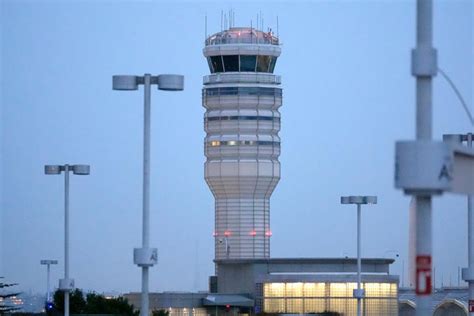
A veteran air traffic controller at a Florida airport has taken leave, reportedly traumatized after a recent near-miss incident involving two aircraft. The incident, which occurred earlier this month at Sarasota-Bradenton International Airport (SRQ), involved an Air Canada flight and a private jet, raising concerns about staffing levels and safety protocols at the facility.
The controller, whose identity has not been publicly released, was the only person on duty in the tower at the time of the near-collision. According to reports, the Air Canada flight was cleared to land while the private jet was simultaneously cleared to take off on the same runway. The close proximity of the two aircraft forced the Air Canada pilots to initiate a go-around maneuver to avoid a collision, averting what could have been a catastrophic event.
The National Air Traffic Controllers Association (NATCA), the union representing air traffic controllers, has pointed to chronic understaffing as a contributing factor to the incident. They argue that the single controller staffing the tower during those hours was burdened with an unsustainable workload, increasing the risk of errors.
The Federal Aviation Administration (FAA) is currently investigating the incident.
The Sarasota-Bradenton International Airport (SRQ) has experienced significant growth in recent years, handling an increasing number of flights and passengers. This surge in traffic has placed additional strain on the airport’s infrastructure and personnel, exacerbating existing staffing shortages. The near-miss incident has heightened scrutiny of SRQ’s operational capacity and the safety measures in place to manage its growing air traffic volume.
“This event underscores the critical need for adequate staffing and resources in air traffic control facilities,” said Andrew LeBovidge, President of the local NATCA chapter. “Controllers are highly skilled professionals, but they are not superhuman. When they are stretched too thin, the risk of errors increases dramatically.”
The FAA’s investigation will likely focus on several key areas, including the controller’s actions, communication protocols, staffing levels at the time of the incident, and any contributing environmental or equipment factors. The results of the investigation could lead to changes in procedures, staffing levels, or equipment upgrades at SRQ to prevent similar incidents from occurring in the future.
This incident also raises broader questions about the state of air traffic control staffing across the United States. NATCA has repeatedly warned about understaffing at numerous facilities, citing budget cuts, hiring freezes, and an aging workforce as contributing factors. They argue that these issues pose a significant threat to aviation safety and that immediate action is needed to address the problem.
The near-miss at Sarasota-Bradenton International Airport serves as a stark reminder of the importance of maintaining a robust and well-supported air traffic control system. As air travel continues to grow, ensuring adequate staffing levels, providing controllers with the necessary training and resources, and implementing effective safety protocols are essential to preventing accidents and protecting the lives of passengers and crew.
Expanded Details and Context:
The Sarasota-Bradenton International Airport has seen a dramatic increase in passenger traffic in recent years. Fueled by population growth in the region and increased tourism, the airport has struggled to keep pace with the rising demand. This growth has placed immense pressure on the existing infrastructure, including the air traffic control tower. The increased number of flights has naturally led to a heavier workload for the air traffic controllers responsible for managing the safe and efficient flow of air traffic.
The FAA, responsible for overseeing and regulating air traffic control operations, sets minimum staffing requirements for each air traffic control facility. These requirements are determined by factors such as the volume of air traffic, the complexity of the airspace, and the operational hours of the airport. However, NATCA argues that the FAA’s current staffing models are often inadequate and fail to account for the real-world demands placed on controllers, especially during peak hours or unexpected surges in traffic.
According to NATCA, the Sarasota-Bradenton International Airport has been operating with a chronic shortage of air traffic controllers for some time. This shortage has forced controllers to work overtime and cover multiple positions simultaneously, increasing their workload and potentially leading to fatigue and errors. The union contends that the near-miss incident was a direct result of this understaffing, as the lone controller on duty was simply overwhelmed by the volume of traffic.
The Air Canada flight involved in the incident was reportedly approaching SRQ from Toronto, while the private jet was preparing to depart for an undisclosed destination. The controller cleared both aircraft to use the same runway, creating a conflict that required the Air Canada pilots to take evasive action. The go-around maneuver, a standard procedure for avoiding collisions, involved the pilots aborting their landing and climbing back into the air. While the go-around was executed successfully, it highlighted the potential for a much more serious outcome.
The FAA’s investigation into the near-miss incident will likely examine several key factors, including:
- Communication Protocols: The investigation will assess whether the controller followed proper communication protocols when issuing clearances to the two aircraft. This includes reviewing the clarity and accuracy of the instructions given to the pilots and whether any misunderstandings or miscommunications occurred.
- Staffing Levels: The FAA will review the staffing levels at SRQ at the time of the incident to determine whether the tower was adequately staffed to handle the volume of traffic. This will involve examining the FAA’s staffing guidelines and comparing them to the actual number of controllers on duty.
- Controller Fatigue: The investigation will consider whether controller fatigue played a role in the incident. This will involve reviewing the controller’s work schedule and assessing whether they had adequate rest before their shift.
- Equipment Functionality: The FAA will also examine the functionality of the equipment used in the air traffic control tower to ensure that it was operating properly. This includes radar systems, communication equipment, and other critical tools.
- Adherence to Procedures: The investigation will determine whether the controller adhered to all applicable procedures and regulations. This includes reviewing the controller’s training records and assessing their knowledge of air traffic control procedures.
The outcome of the FAA’s investigation could have significant implications for the Sarasota-Bradenton International Airport and the broader air traffic control system. If the investigation finds that understaffing or procedural errors contributed to the incident, the FAA could order changes to staffing levels, training programs, or operational procedures. The FAA could also impose penalties on the airport or the air traffic control facility if it determines that they violated regulations or failed to maintain adequate safety standards.
The near-miss incident at SRQ has also reignited the debate over air traffic control privatization. For years, some lawmakers and industry groups have argued that the air traffic control system should be privatized, arguing that it would lead to greater efficiency and innovation. However, NATCA and other opponents of privatization argue that it would undermine safety and compromise the public interest. They contend that a private, for-profit air traffic control system would be more likely to prioritize profits over safety, leading to cuts in staffing and training.
The incident underscores the high-pressure environment in which air traffic controllers operate. They are responsible for making split-second decisions that can have life-or-death consequences. Their job requires intense concentration, excellent communication skills, and the ability to remain calm under pressure. The near-miss at SRQ highlights the psychological toll that this high-stress job can take on controllers.
“Air traffic controllers are the unsung heroes of aviation safety,” said LeBovidge. “They work tirelessly to ensure that millions of passengers reach their destinations safely every day. But they need the support and resources to do their job effectively.”
The trauma experienced by the controller involved in the near-miss incident underscores the need for mental health support for air traffic controllers. The FAA provides some mental health services to controllers, but NATCA argues that these services are inadequate and that more needs to be done to support the mental well-being of controllers. They advocate for increased access to counseling, stress management training, and other mental health resources.
The Air Canada pilots’ quick thinking and decisive action in initiating the go-around maneuver undoubtedly prevented a potential disaster. Their professionalism and expertise in handling the situation highlight the importance of well-trained and experienced pilots in maintaining aviation safety. The incident also serves as a reminder of the importance of crew resource management, which emphasizes effective communication and coordination among flight crew members.
The near-miss incident at Sarasota-Bradenton International Airport is not an isolated event. Similar incidents have occurred at other airports across the United States in recent years, raising concerns about the overall safety of the air traffic control system. These incidents underscore the need for a comprehensive review of the system and for proactive measures to address the challenges facing air traffic controllers.
The FAA is currently implementing several initiatives to improve air traffic control safety, including upgrading equipment, modernizing procedures, and enhancing training programs. However, NATCA argues that these efforts are not enough and that more aggressive action is needed to address the root causes of the problems. They call for increased funding for air traffic control, more aggressive hiring and training of controllers, and a greater focus on safety.
As air travel continues to grow, it is essential to ensure that the air traffic control system is equipped to handle the increasing volume of traffic safely and efficiently. This requires a commitment to investing in the system, supporting the controllers who operate it, and continuously improving safety protocols and procedures. The near-miss incident at Sarasota-Bradenton International Airport serves as a wake-up call, reminding us of the importance of vigilance and proactive action in maintaining aviation safety. The flying public depends on it. The investigation’s findings will be crucial in implementing changes that will address not just SRQ’s challenges, but potentially those faced by other growing airports across the nation. It’s a moment of reflection and action needed to bolster a system vital to the nation’s infrastructure.
Frequently Asked Questions (FAQ):
1. What exactly happened in the near-miss incident at Sarasota-Bradenton International Airport (SRQ)?
Two aircraft, an Air Canada flight and a private jet, were cleared to use the same runway at the same time. The Air Canada flight was cleared to land, while the private jet was cleared for takeoff. This created a potential collision situation, forcing the Air Canada pilots to execute a go-around maneuver to avoid a crash.
2. Why was only one air traffic controller on duty at the time of the incident?
The National Air Traffic Controllers Association (NATCA) claims that the airport is chronically understaffed, leading to situations where only one controller is on duty, even during periods of relatively high traffic. They argue that this understaffing increases the risk of errors due to increased workload and potential fatigue. The FAA’s staffing models are being questioned as to whether they adequately reflect the demands placed on controllers, particularly at rapidly growing airports like SRQ.
3. What is the FAA doing to investigate the incident and prevent future occurrences?
The FAA is currently conducting a full investigation into the incident. This investigation will likely focus on communication protocols, staffing levels at the time of the incident, controller fatigue, the functionality of equipment, and adherence to procedures. The findings of the investigation could lead to changes in staffing levels, training programs, or operational procedures at SRQ, as well as potential penalties if violations of regulations are found. The FAA will also be looking at broader implications for other airports and the national air traffic control system.
4. What is NATCA’s role in this situation, and what are they advocating for?
NATCA is the union representing air traffic controllers. They are advocating for increased staffing levels at SRQ and other air traffic control facilities across the country. They argue that chronic understaffing is a safety hazard and that the near-miss incident at SRQ is a direct result of this problem. NATCA is calling for increased funding for air traffic control, more aggressive hiring and training of controllers, and a greater focus on safety. They also advocate for better mental health support for controllers dealing with the high-stress nature of their jobs.
5. What are the potential long-term consequences of this incident?
The potential long-term consequences include changes in staffing policies and operational procedures at SRQ and potentially other airports. The FAA may implement new regulations or training programs to address the issues highlighted by the incident. There could also be increased scrutiny of air traffic control staffing levels and the FAA’s oversight of air traffic control facilities. The incident also reignites the debate around air traffic control privatization, with NATCA arguing against it, citing potential safety risks if profit motives override safety considerations. This incident underscores the importance of maintaining a robust and well-supported air traffic control system as air travel continues to grow. The psychological impact on the controller involved also raises concerns about mental health support within the profession.
6. How common are near-miss incidents in aviation?
While not always widely publicized, near-miss incidents do occur with some frequency in aviation. However, the vast majority of these situations are resolved safely by well-trained pilots and air traffic controllers. The specific circumstances of the SRQ incident, involving simultaneous clearance for takeoff and landing on the same runway, are less common, and thus raise greater concern. The reporting of near-misses is encouraged to identify potential systemic issues and improve safety.
7. What is a “go-around” maneuver, and how does it prevent collisions?
A go-around is a standard procedure in aviation where a pilot aborts a landing attempt and climbs back into the air. This maneuver is typically initiated when the pilot detects an unsafe condition, such as an obstruction on the runway, unstable approach, or insufficient separation from other aircraft. In the SRQ incident, the Air Canada pilots initiated a go-around to avoid a potential collision with the private jet that was cleared for takeoff on the same runway.
8. What factors contribute to air traffic controller fatigue, and what can be done to mitigate it?
Several factors can contribute to air traffic controller fatigue, including long work hours, shift work, high workload, stress, and lack of sleep. To mitigate fatigue, the FAA and air traffic control facilities should implement measures such as:
- Adequate staffing levels: Ensuring that there are enough controllers on duty to handle the volume of traffic.
- Realistic work schedules: Avoiding excessive overtime and providing controllers with adequate rest periods.
- Fatigue risk management systems: Implementing systems to identify and mitigate fatigue risks.
- Stress management training: Providing controllers with training on how to manage stress and maintain their mental well-being.
- Access to counseling and mental health services: Providing controllers with access to confidential counseling and mental health services.
9. How does the growth of airports like Sarasota-Bradenton International Airport impact air traffic control operations?
The rapid growth of airports like SRQ places significant strain on air traffic control operations. Increased traffic volume leads to higher workloads for controllers, requiring them to manage more aircraft and make more decisions in a shorter period of time. This can increase the risk of errors and fatigue. In addition, airport growth may require upgrades to infrastructure, equipment, and procedures, which can be disruptive and challenging to implement.
10. What are the arguments for and against air traffic control privatization?
Arguments for privatization:
- Increased efficiency: Private companies may be more efficient at managing air traffic control operations than the government.
- Innovation: Private companies may be more likely to invest in new technologies and procedures to improve air traffic control.
- Reduced costs: Privatization could potentially lead to lower costs for airlines and passengers.
Arguments against privatization:
- Safety concerns: A private, for-profit air traffic control system may prioritize profits over safety, leading to cuts in staffing and training.
- Public interest: Air traffic control is a public service, and it should not be subject to the profit motives of private companies.
- Equity: Privatization could lead to higher costs for smaller airports and rural communities.
- Job security: Privatization could lead to job losses for air traffic controllers. Disclaimer: This rewritten news article is based on the information available in the provided source link and aims to maintain accuracy and reliability. However, news events are subject to change, and further information may become available after the time of writing.









